 
Colecto
The Collection Equipment Corporation
B. Nicoll & Company Inc.,
New York, New York
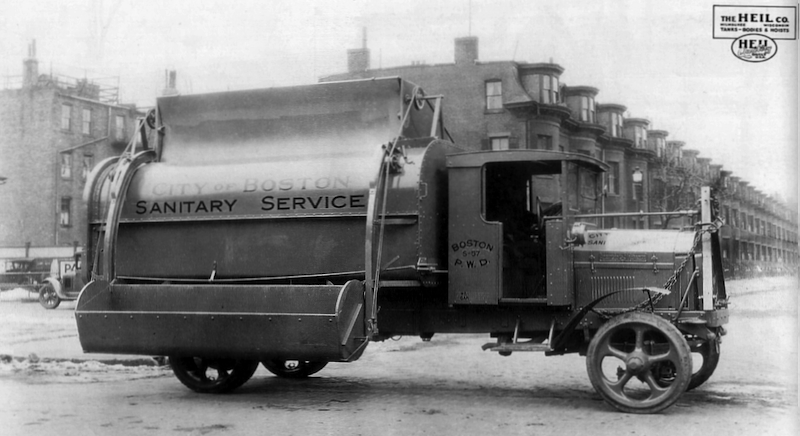
The City of Boston bought this 15-yard Colecto side loader in 1929
Authors note: The following two chapters are included in this history because Colecto was loosely associated with Heil in its early years, and was eventually absorbed into the company.
EARLY COLECTO
The Collection Equipment Corporation was one of the first to market mechanized bodies specifically designed for municipal refuse service. Known as the Colecto, the product was mostly successful, given the difficult economic conditions during the years in which the company was in business. When one also considers that the concept of specialized refuse equipment was almost entirely new in the 1930s, the Colecto must be seen as a tremendous success. Despite very few competitors, the path would still be a difficult one for the new company, which pioneered many innovative designs in a constant quest for a model that would break open the market. By 1940, Municipal Sanitation Corporation (the company name from 1933 forward) seemed to be on the cusp of that breakthrough, only to have the bottom drop out as the United States would eventually enter the Second Word War. When the company folded, they had left a record of steadily improving designs, and become the first truly successful independent manufacturer of refuse bodies.
In the beginning, Colecto bodies were sold through B. Nicoll and Company Inc, a highly successful firm owned by a well-connected New York family. They could trace their American roots to 1664, when Mattias Nicoll arrived at what was then New Amsterdam as an official with the British colonial administration. In 1672, he was appointed 6th Mayor of New York City, and through land grants owned much of present-day Long Island. Benjamin Nicoll was born about 1855, and sold ore for a mining company before starting New Jersey-based B. Nicoll & Company in the 1880s. Here, he made his fortune as a trader and import-export sales agent of steel, and added coal by the turn of the century. In January 1921, the firm was incorporated in New York, setting up offices at 292 Madison Avenue, New York City. However, Nicoll died suddenly in June of that year. Presumably, his son Courtlandt Nicoll took over in his stead, having been an officer of the company for many years. Courtlandt served as a New York City Alderman and in also the state senate.
The first Colecto refuse bodies were announced in 1928, from a patented design by William S. Howard. They were available in either 10 or 15-cubic yard capacity, and were very similar and concept and appearance to The ATIA, their only real competitor at the time. In fact, the Colecto looked so much like the ATIA Refuse Collector that the two are easily mistaken for one another. Both were side bucket self-loading bodies with a dust-proof shutter. The only substantial difference was in the lift mechanism which attached to the bucket. The Colecto used an endless roller chain loop, with two cables attached to the loop which raised the bucket. The bucket was drawn up, and then back down in an almost continuous motion, while the power take-off never changed its rotational direction. By contrast, the ATIA had a drive system more like a conventional winch, which had to be reversed to move the bucket back and forth from loading to dumping position. Additionally, the Colecto had a connection from the vehicle driveline that was constant, through a horizontal driveshaft and u-joint, while the ATIA had a vertical shaft with separable connection, which split from the vehicle PTO when the body was raised to dump. Neither unit had any compaction means, with the load being emptied out a rear door by tilting the body.
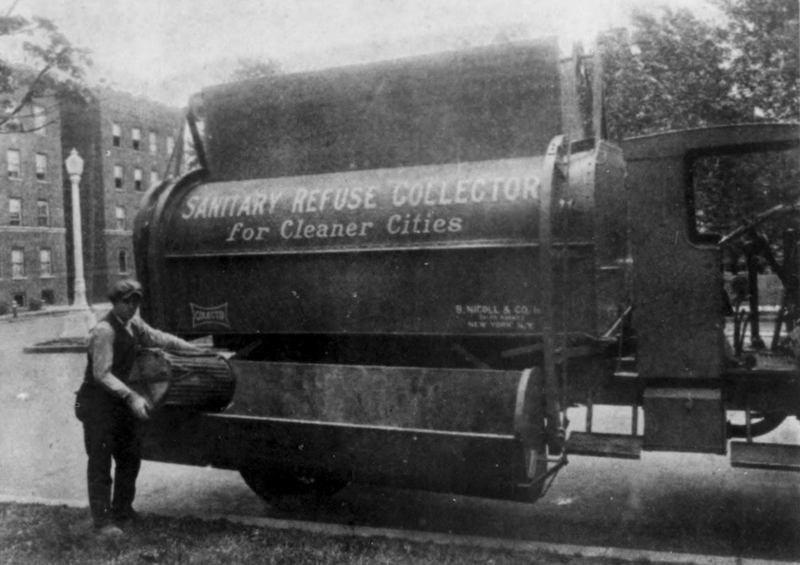
1928 Colecto 10-yard demonstrator showing the 10' x 22" width side-loading bucket
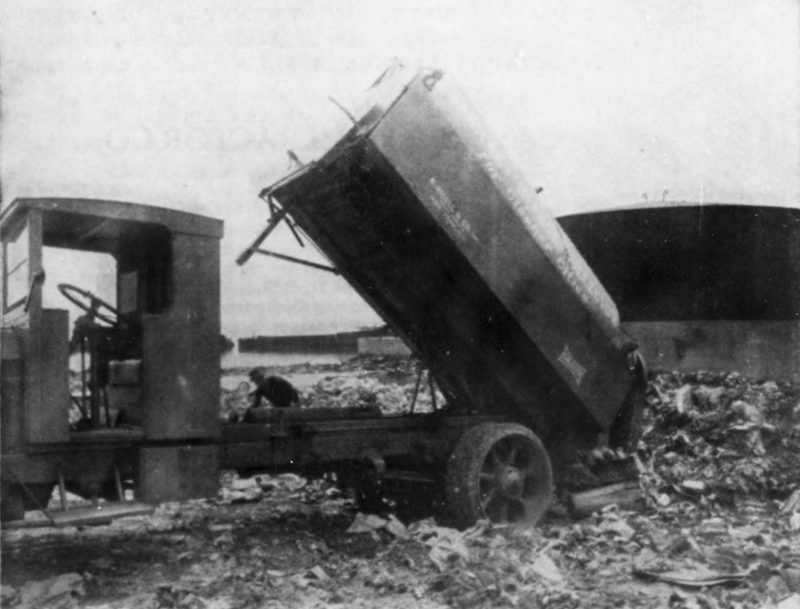
1928: dump angle of 45-degrees achieved with either mechanical or hydraulic hoist
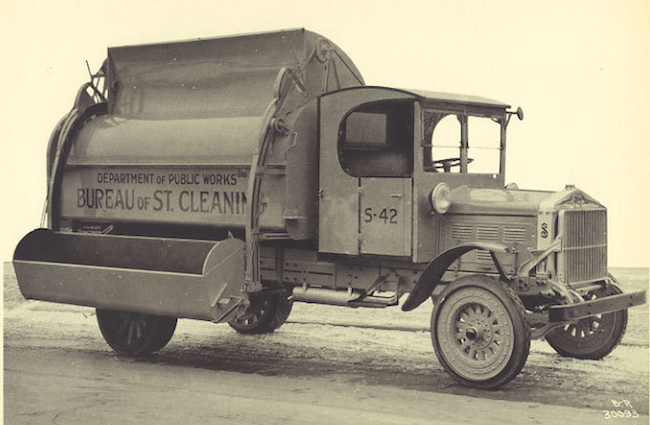
One of 34 Sterling trucks with Colecto bodies and Heil hoists purchased by Philadelphia in 1930
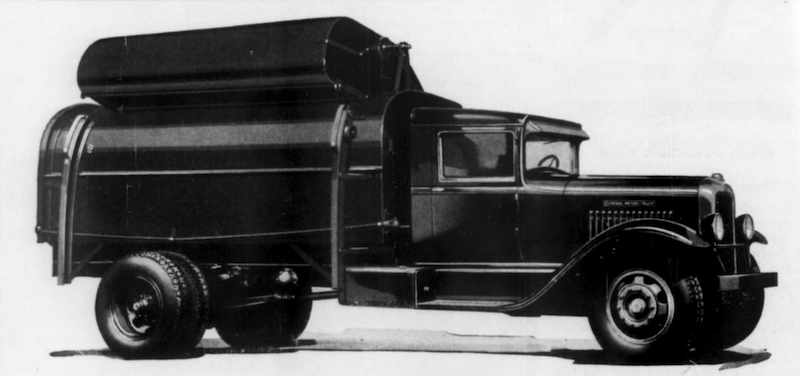
By 1930, Asbury Park, New Jersey had a small fleet of Colectos on GMC truck chassis like the one illustrated above
THE HEIL CONNECTION
When the Colecto hit the market in 1928, The Heil Company was already one of the biggest truck body manufacturers in the country, and was also manufacturing hydraulic hoists. Based in Milwaukee, the company had several eastern branch offices and a factory in Hillside, New Jersey. Heil is definitely known to have supplied underbody hoists used on the early Colecto, and their stamp appears on some Colecto photos of the time. These photo may have been used to merely to promote the underbody hoists, but it is also possible that Heil actually built some or all Colecto bodies under contract.
B. Nicoll and Company, which was the sales arm for Colecto, had their offices on Broadway in New York City. This was hardly a hotbed of truck manufacturing activity. By contrast, Heil was a company with the experience, manufacturing capability and extensive dealer network that would have made them an ideal candidate to build Colecto bodies for B. Nicoll. This is purely speculative, and hopefully, future research will eventually settle the question. However, it is a fact that Heil would figure prominently in the future of Colecto by the early 1940s.
COLECTO REAR LOADER: FIRST GENERATION
William Howard designed a rear-trough version of the Colecto in 1929, which became the first mass-marketed rear loader, spawning many imitators over the years. In some ways, it can be said to be the forefather of the modern compaction rear loader. Similarly, its rigid lift arms and bucket also pointed the way for the front loaders which would emerge nearly two decades later. This first version rear-load Colecto used the same roller chain arrangement as the side loader, but with a loop on each side of the body. A connecting rod was attached to each loop to the rear trough, which spanned the width of the body. Rotation of the endless chain loops alternately lifted, dumped, and then lowered the trough in a continuous motion.

Shown above left is truck No.2, City of East Rutherford, New Jersey, from a 1930 advertisement. This is one of two known images of a first generation Colecto rear loader. The illustration at right shows the endless roller chain drive (53) and connecting rod (50) used to raise the bucket arms. Another roller chain at the front of the body (71) connected the PTO to a cross shaft, which turned the chain drive sprockets. The body was tilted to dump by a cam-and-roller type hydraulic hoist. This was a short-lived design, but set the stage for several improved models which followed. Leach, Gar Wood and Galion also fielded rear bucket loaders of this basic type from 1932 until the mid-1950s.
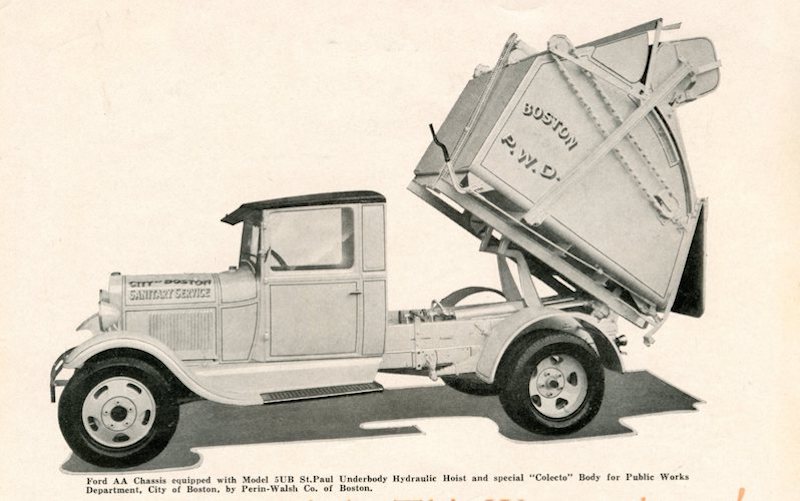
The only other known image of a 1st generation Colecto rear loader. It was in service with the Boston Public Works Department in 1931. The hoist was provided by St. Paul Hydraulic, which had been acquired by Gar Wood Industries the previous year.
|
LEGAL ACTION BY ATIA
As mentioned, Colecto's lone competitor was the ATIA Corporation, which had been selling their side loader since 1925, with patents dating to 1923. Product advertising warned that "any infringements will be vigorously prosecuted". They were true to their word, and inventor William Howard immediately drew a patent infringement lawsuit. Somewhat miraculously, Howard actually prevailed in court on a technicality, due in part to the differences in the bucket drive between the two models. However, that judgement was quickly reversed on appeal in 1929, with court finding that it was not distinctly different from the ATIA. The appeals court determined that the Colecto was indeed an infringement, unless the ATIA patent could be shown to be invalid, due to prior art or other reasons.
The exact details of what happened in the aftermath of ATIA winning their appeal is unknown. It is possible, even likely, that the two companies reached a settlement, as the Colecto continued to be advertised. However, Colecto steadily implemented changes to their body during the 1930s, which may have been an effort to avoid punitive royalty payments. As for ATIA, that company seems to have all but disappeared by the early 1930s. The dire financial situation in America following the 1929 stock market crash would not have been advantageous for either company, but Colecto was ultimately the one that survived.
COLECTO SHORT-BUCKET SIDE LOADER
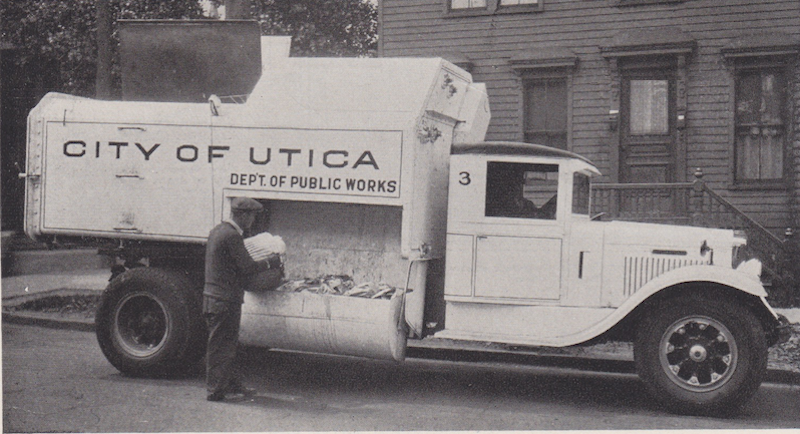
1932 Colecto short-bucket side loader
By 1930, Colecto had released an updated version of their side loader with a smaller bucket, spanning approximately half the length of the body. The bucket was now fully enclosed during most of its travel into the body, reducing dust. The body could be tipped periodically if it became necessary to consolidate the load towards the rear. The back end of the body could also be manually loaded through roof-level doors, which were advertised as being made for snow loading. This latter feature would seem to be an attempt at attracting municipal customers, particularly the DSNY, who were also responsible for snow removal. The bucket lift system appears to have been the same as on the early model Colecto, using roller chain drive connected to the lift cables for continuous raise/lower motion.
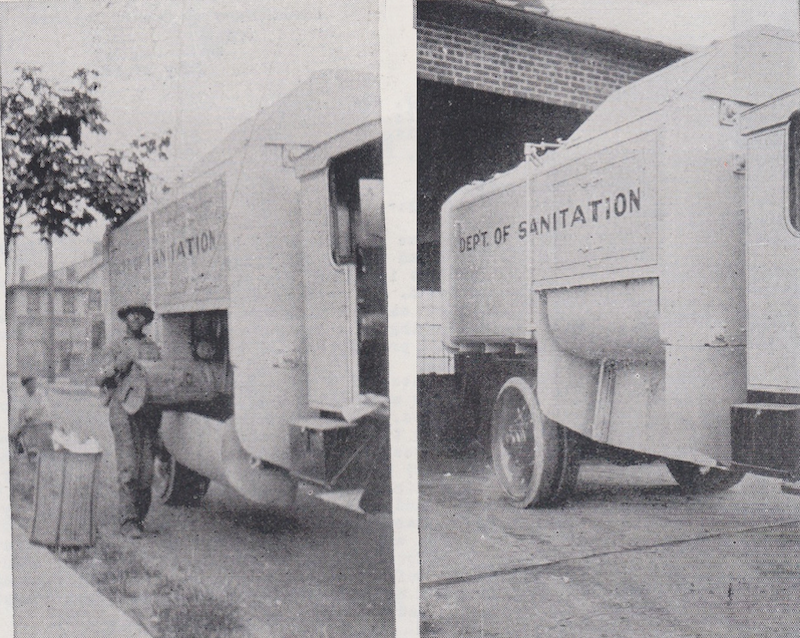
Colecto short-bucket side loader demonstration from a 1930 advertisement
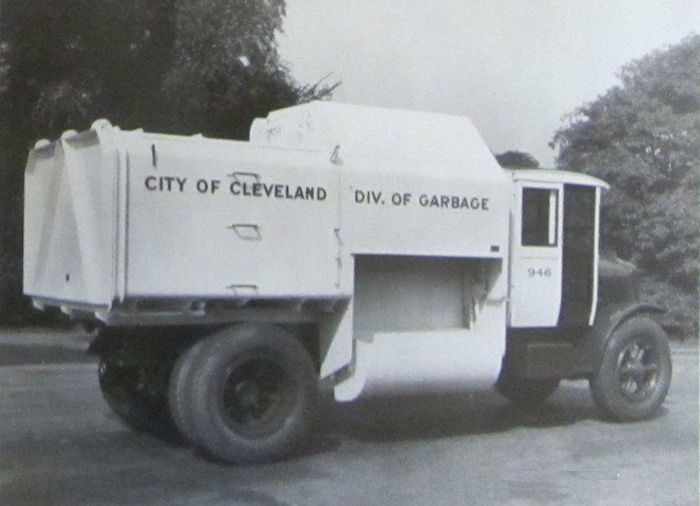
City of Cleveland Colecto on White chassis
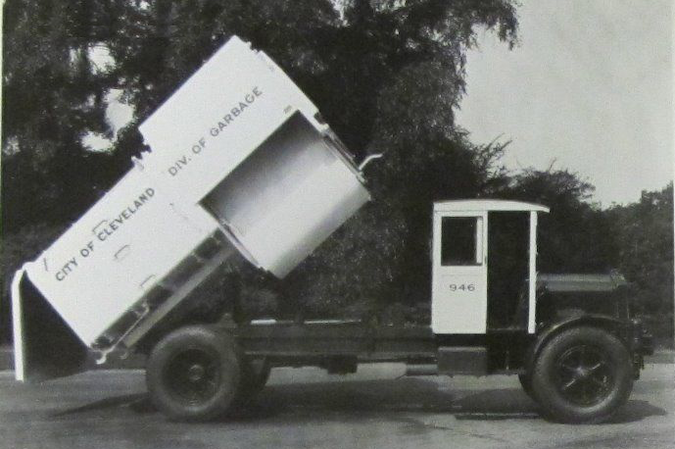
Tilting body for consolidating the load, or dumping it with the rear door unlocked
Yet another big change happened in 1931, when the Elgin Sales Corporation briefly took over distribution of the Colecto refuse bodies. Elgin was a sales organization formed by George C. Dodge and A.M. Anderson, which distributed the famous Elgin motorized street sweeper for an Illinois manufacturer. Additionally, they sold a vacuum catch-basin cleaner made by a small Wisconsin firm known as the Leach Company. According to David Leach in his book Good Riddance to Bad Rubbish, Elgin lost the Colecto contract after a little more than a year due to poor sales. Dodge and Anderson immediately went to Leach with a proposal to build a comparable refuse truck, which resulted in the famous Leach Refuse Getter.
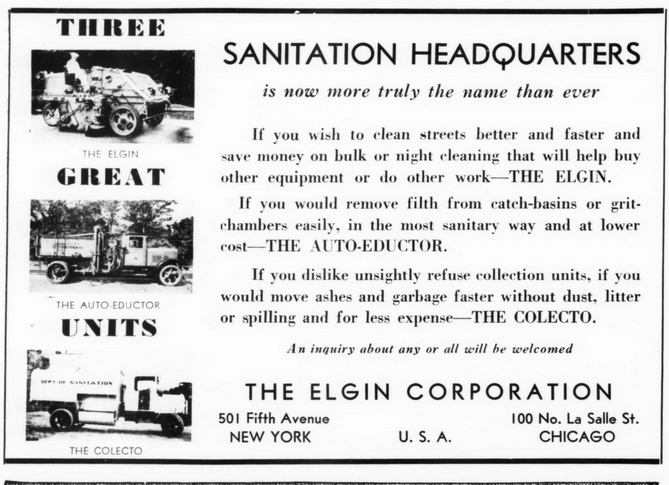
SELECTED PATENTS:
|
Patent # |
Description |
Inventor |
Assignee |
Date |
|
US1833872 |
Self-Loading Vehicle (Colecto side loader) |
William S. Howard |
Collection Equip. Corp. |
April 5, 1928 |
|
US1865318 |
Self-Loading Vehicle (Colecto rear loader-chain drive) |
William S. Howard |
Collection Equip. Corp. |
September 11, 1929 |



7/2/16 (updated 5/11/24)
© 2016. 2021, 2024
All Rights Reserved
Photos from factory brochures/advertisements except as noted
Logos shown are the trademarks of respective manufacturers
|
| |